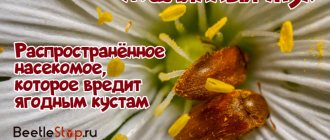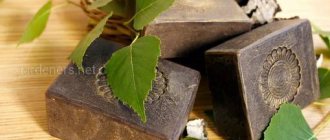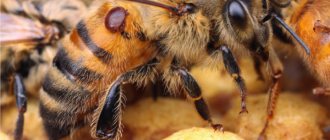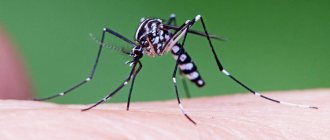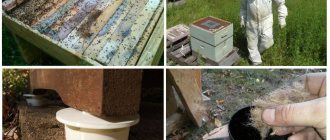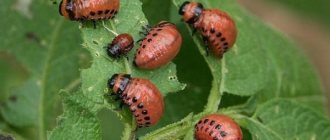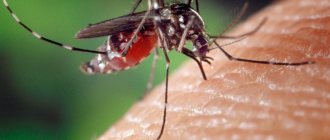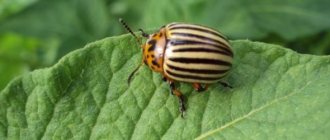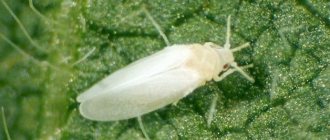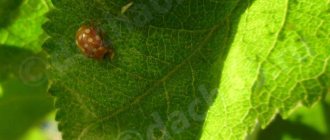Carrots are a tasty root vegetable not only for people and animals, but also for insects. At the same time, pests are not repelled by the specific smell of the crop, so they eat the root crop and the green part of the vegetable during the growing season. I will tell you in detail about carrot pests, signs of damage, prevention and control measures.
carrot fly
The carrot fly is dangerous for the Umbelliferae family - carrots, parsley, celery. The danger is that by laying larvae 1-2 times per season, the insects hatch and bite into growing root crops in search of food. The carrot fly begins laying eggs in mid-May. Second clutch of offspring in mid-July. For gardeners who sow early carrots starting in mid-April, the carrot fly is a worst pest that does not spare root crops, eating them on the vine.
carrot fly
Causes of flies:
- rainy warm summer;
- non-compliance with crop rotation;
- violation of agrotechnical requirements.
Preventive actions to avoid the appearance of flies:
- start sowing in late May - early June;
- the distance between seeds is 2-4 cm (thinning seedlings does not reduce the appearance of the pest);
- The landing site should not be located on a hill;
- plant onions, cilantro, marigolds, and calendula near the beds;
- reduce crop watering;
- mulch the beds with sawdust or straw so that the fly cannot lay eggs;
- choose crop varieties that are not susceptible to pests;
- the fly overwinters in the lower layers of the soil, so autumn digging will raise the larvae into the cold, where they will not survive.
If a fly appears on the site, you will have to fight it for a long time. Fighting methods:
| Traditional methods | Chemical and biological drugs |
| Wormwood . To prepare the decoction you will need: fill a bucket of freshly cut wormwood with water and boil for 7-12 minutes. Dilute the resulting decoction with water in a ratio of 1:10, that is, for 1 liter of concentrated decoction, 10 liters of clean water. Treat foliage and roots, but not more than once every 10 days. | Prestige |
| Onion broth . The fly does not tolerate the smell of onions and garlic, so the method is effective if sprayed regularly: chop 2 large heads of onion or garlic, pour 2 liters of boiling water, leave overnight. Strain. Perform the procedure once a week. | Fly eater |
| Ammonia . Dilute 2 tbsp. ammonia in a bucket of water. First water the beds with plain water, and after soaking, spill the soil with ammonia. | Aktara |
| Tomato tops . Preventing the appearance of flies is to plant carrots after tomatoes, but tomato tops are also capable of driving away the pest. Pour a bucket of boiling water over 5 kg of tops and cook over low heat for 3 hours. Strain, add 2 tbsp. liquid soap. Add a couple of liters of water and spray. | Arrivo |
| Ash. Periodic dusting with wood ash. | Corado |
The frequency and dosage of drug application is indicated by the manufacturer on the packaging.
Carrot fly protection
Alternaria, or black rot
The above-ground part of carrots is a tasty morsel for black rot
Alternaria blight or black rot affects the ground part of carrots: brown spots appear on the surface of the leaves. Then the infection spreads, the leaf plates completely die off, after which the fungus spreads to the upper part of the root crop, causing it to rot.
Alternaria most often affects carrots in damp and humid summers. The source of infection is plant debris and weeds. To avoid the spread of the disease, it is important to burn all carrot tops after harvesting and thoroughly clear the area of weeds.
psyllid
Psyllids are small insects that feed on plant sap, leaving behind a sticky coating. These include grass fleas and copperheads. The carrot psyllid, up to 5 mm in size, changes body color depending on the time of year: bright in summer, dull in autumn. Flight to the beds has been observed since the second ten days of July.
carrot psyllid
Depending on the species, the carrot psyllid eats not only carrots, but also destroys fruit trees. A sign of carrot infection: the foliage curls, becomes terry, and slows down in growth. The taste of damaged root vegetables deteriorates. When laying eggs, adults secrete enzymes that contain sugars, which attracts ants. The plaque sticks the foliage together - it becomes smaller, and fungi develop.
At the first sign of an insect, you should get rid of it.
| Folk remedies | Chemical and biological |
| Tobacco dust + ash . Mix dry tobacco dust with ash (1:1), add a bucket of water, leave for 2 days. Strain, add 2 parts water and 30 g tar soap. Spray the tops once a week for a month. | Vantex |
| Onion or garlic broth . For 300 g of onion or garlic you will need 1.5 liters of water. Bring to a boil, leave overnight. Strain the solution and spray the plants. | Decis |
| Ash dusting . Sprinkle the tops with ash on a windless day, mainly in the evening. | Boreas |
Chemical treatment must be carried out 3-4 weeks before harvest.
Prevention of psyllids:
- pre-winter sowing of seeds;
- choosing a planting site away from coniferous trees;
- regular loosening and weeding of beds.
Please note that if there is a small amount of psyllid, the green part can be irrigated with a decoction of yarrow + dandelion. The insect does not tolerate the specific smell of plants.
Garden and umbrella moths
The umbrella moth is otherwise called carrot or dill moth, since the butterflies begin their massive flight during the period of active growth of the tops.
Umbrella moth
It is the larvae that are destructive that the moth lays in the inflorescences of the seed plants of the crop. As the larvae grow, they eat plants and remain in the inflorescences for a long time. If 4-5 caterpillars appear on the plantings, then the pest should be destroyed with biological products. The caterpillars secrete a web, which causes the umbrellas and inflorescences of the carrots to tighten, forming a cocoon. In the same web, the moth lays offspring, which the gardener does not immediately detect.
Vegetable moth caterpillar
Preventing moths:
- timely harvesting of testes;
- regular weeding of beds;
- cleaning damaged inflorescences;
- destruction of wild plants (especially hogweed).
If 1-2 umbrella moth caterpillars are found on carrot plantings, they can be collected manually without using chemicals. The vegetable moth takes root in the southern regions, in particular in the Caucasus, Krasnodar and Crimea. In warm places, moths leave 2-3 generations per season.
If the need to use insecticides does arise, then this must be done a month before harvesting vegetables. Preparations:
- Voliam Flexi - on average, 2 treatments are required;
- Lepidocide;
- Aktellik;
- Enterobacterin.
Among the folk methods, umbrella moth can be overcome by spraying with a soap-ash solution, onion broth, garlic broth, or wormwood solution.
Treatment of diseases
If, despite all efforts to prevent carrot diseases, you find signs of infection in your plantings, emergency medical care will help save the crop:
- for gray rot of carrots, fertilizing with nitrogen fertilizers and spraying with preparations containing copper is necessary; the drug Rovral also helps well;
- white rot does not like potassium fertilizers - feed the carrots with potassium sulfate (1.5 tablespoons per 10 liters of water), it is also worth spraying the beds with Gliocardin;
- the drug Rovral helps well against black rot;
- with brown spotting, loosening the beds will help; for treatment, use the preparations Bravo, Quadris, Hom;
- fungicides Fitosporin-M, Topsin-M and copper sulfate (0.5%) save from powdery mildew;
- cercospora infection is effectively treated with biological products Quadris and Gamair;
- To prevent bacteriosis, carrots for winter storage should be sprayed with TMTD fungicide or dusted with chalk dust.
Root nematode
The root-knot nematode is a parasite (worm) that lives in the stem part of plants, eats roots, fruits, and sucks juices from the leaves of vegetable crops. It is easy to introduce the pest into the beds:
- with new soil, since the pest lives in the soil;
- through fallen leaves, humus;
- through inventory.
Root-knot nematode infection can be determined by looking at the roots. The roots swell and bubble. The green part looks painful, the fruits become smaller and stop growing.
Root-knot nematode on carrots
Preventive actions to prevent wormy carrots from appearing in the beds:
- follow the rules of crop rotation;
- dig up the soil annually;
- rid the beds of weeds;
- plant repellent plants - calendula, marigolds - in the aisles;
- Periodically sterilize gardening tools.
Destroying root-knot nematodes is a tedious task, since the pest leaves 4-6 generations per season. At the same time, folk remedies for getting rid of them may not help, since the worms are protected by dense layers of the body, and in the lost time the parasite will damage part of the plantings.
In the fight against root-knot nematodes, it is worth taking decisive measures, for example using nematicides. These are substances with low toxic effects on humans, but dangerous for nematodes. Drugs: Nematorin, Nematofagin, Basamil. Dosages and timing of drug administration are indicated by the manufacturer on the label.
Causes of pests on carrots
Most often, the appearance of a certain type of pest depends on the conditions created and suitable only for it.
Generally speaking, the appearance of pests is influenced by the lack of crop rotation. Carrots are planted in the same place for several years in a row. As a result, parasites get used to the fact that this place is safe and there is always something to profit from.
One of the reasons for the appearance of pests may be an unsuccessfully chosen place for a carrot bed. It should not be placed in the shade or separately from the entire garden. It is better not to plant carrots next to coniferous plants.
Another reason for the appearance of pests on carrots may be the use of the same feeding or fertilizer. Or their timely introduction into the soil.
Well, the last reason is unsuitable climatic conditions - extreme heat or cold and dampness. Unfortunately, the gardener cannot influence this in any way. But it can slightly regulate climatic conditions by watering.
naked slug
Slugs and snails live in cool, damp places, such as under stones, boards, and leaves. The southern regions where there is high humidity suffer from shellfish. Pests do not like sunlight and heat, so they crawl out at night to search for food. In cold summers, slugs attack the garden even during the day, crawling out in cloudy weather, eating not only carrots, but also other vegetables and berries, leaving holes in them.
naked slug
Naked slugs love shade, so removing weeds is a good way to prevent their appearance. If carrot pests appear on the site, you can catch them using live bait: place a board or slate in a cool, damp place for 5-7 days. Water the soil with water, increasing the humidity. Leave cabbage leaves nearby and pour in a little kefir or beer. Slugs willingly crawl onto the trap, so within a couple of days they can be collected by hand and destroyed.
Summer residents have also identified effective methods to combat slugs:
- Tobacco infusion . Pour 200 g of dry tobacco dust (sold in garden stores) with a liter of water and leave for 24 hours. Boil for an hour, then leave to infuse again overnight. Dilute tobacco concentrate with 2 liters of water + 15 g of laundry soap (preferably liquid). Spray the plants in the evening, when the concentration of slugs is maximum.
- Mustard solution . Dilute 1 tbsp in a liter of hot water (50°C). dry mustard. Spray the beds in the evening.
- Saline solution . Dilute salt in hot water (2 tablespoons of table salt per 1 liter), add 1 tablespoon. baking soda. Stir and spray with warm solution after sunset.
Treatment with saline solution is carried out once every 3 days.
Wireworm
The wireworm loves to feast on vegetables. It leaves holes in the root crops. It can be found on potatoes, carrots, and tomatoes. The lifespan of the pest is from 2 to 5 years. In cool and humid weather, the wireworm moves along the top layer of soil, and during drought it goes underground up to 0.7 m. It is possible to get rid of larvae and adults using traditional methods or chemical ones. For example:
- watering carrots with onion broth;
- herbal tincture: a kilogram of nettle + 200 g of dandelion leaves, pour a bucket of hot water, leave overnight, then water the crop;
- reduce the acidity of the soil with ash or lime: sprinkle dry matter on the beds at the rate of 500 g per 1 sq.m;
- in case of mass appearance, drugs such as Aktara, Etonem will help.
Wireworms on carrots
Prevention of the appearance of wireworms is eggshells, as well as adding ammonia to the soil. Finely chop the shells and add them to the ground when sowing seeds. Add ammonium nitrate when digging the garden (25 g per 1 sq.m. of land).
Pests of carrot roots
Pests on carrot roots are much more difficult to notice than on tops. Often their activity becomes visible only when the crop is dug up.
To prevent their appearance, remove all plant remains from the ground in the fall. In spring, treat the soil with boiling water and a weak solution of manganese. Also treat purchased seeds before sowing. Before transplanting into a common bed, keep the seedlings separate from other plants. Observe her condition.
You can add ammonium nitrate to the ground against wireworms. And kerosene from the bear.
Winter and exclamation armyworms
Cutworms are popularly called moths. The cutworm can be found in plantings in mid-summer. In the caterpillar stage, the insect gnaws through the leaves of weeds and moves to the stems as it grows. Adult cutworms can be found during the day; larvae and caterpillars feed and crawl out mainly at night.
exclamation scoop
The cutworm is destructive to carrots and cabbage. Insecticides will help get rid of it:
- Iskra-M: for spraying you will need 1 ml of solution per 1 liter of water;
- Karbofos;
- Bifenthrin.
The winter cutworm resembles a moth in appearance. It is not easy for a summer resident to deal with cutworms, as they lay 2000 eggs per season, which are difficult to notice. The winter armyworm is repelled by the smell of yarrow and chamomile. Also, cutworms do not like the aromas of burdock and calendula. The insect does not tolerate water, so regular sprinkling will help reduce their occurrence. Preparations for combating fall armyworm:
- Arrivo;
- Fentiuram;
- Decis.
Winter armyworm
Irrigation of the tops is carried out after sunset, when the caterpillars crawl up.
Gardener questions
Who eats carrots in a garden bed in the ground
Most often it is a carrot fly. She lays larvae in carrots, and they gnaw out thin, deep tunnels. When the invasion is severe, black depressions appear on the carrots. After this, the fruits deteriorate, acquire a bitter taste and can become infected with fungal diseases.
Wireworms also make narrow and deep passages. It happens that the mole cricket eats up all the pulp, leaving only the peel of the carrot.
If the bites are clearly visible to the naked eye, then most likely they are mice.
Who is nibbling carrots from above?
If the tops are not very damaged, and it looks more like they have dried out, then these are insect pests such as aphids, fleas or cutworms. They are difficult to notice with the naked eye and you need to look very closely to find them, because they are small and green. And if the tops seem to have been bitten, then there may be slugs. Carefully examine the surroundings, maybe you will find their hideout. It happens that hares or mice cause such damage.
Who cuts carrot tops in the garden
Mole crickets and fall armyworm caterpillars are capable of this. The mole cricket devours everything within a diameter of one and a half meters from its nest. And if you really notice a circle in your ruins, then try digging in the center. You can find her nest. Naturally, it must be destroyed immediately.
And cutworm caterpillars, when they begin to hatch from eggs, are very voracious and can travel a long distance compared to their size.
It happens that it is hares or mice sharpening their teeth.
Whitefly
The insect got its name because of its light wings. Whiteflies can be found on the back of leaves. It feeds on the sap of the plant, gradually destroying it. A trap will help to catch the pest: paint a plate measuring 15x15 cm yellow, spread a layer of honey or molasses to attract whiteflies, fix the plate between the beds. Insects will flock to the color and aroma, but keep in mind that pollinating insects may fly to the smell, so instead of honey, a layer of Vaseline is allowed.
Whitefly
The drug Admiral will help destroy the larvae; Aktara or Fitoverm will act on adult whiteflies.
Preventing the appearance of whiteflies is to plant calendula, garlic, and yarrow along the rows. Ladybugs will become a natural protector of carrots; they eat not only whiteflies, but also other small insects.
Preventive measures
It is necessary to combat carrot pests not only when they appear in the garden, but also with the help of preventive measures. But to achieve the desired result, they need to be carried out regularly.
Basic preventive measures:
- timely removal of weeds;
- periodic loosening of the soil;
- compliance with crop rotation;
- use of green manure;
- planting marigolds, calendula, garlic, and onions nearby;
- compliance with agricultural technology rules;
- removal of vegetation residues;
- autumn digging of the bed.
Important! It is necessary to plant carrots in the same area only after 4-5 years.
Medvedka
It’s unlikely to miss a mole cricket in the garden. The insect, up to 5 cm in size, is brown in color, has powerful front legs and teeth that allow it to dig the ground. The insect has wings, but it does not fly short distances. The mole cricket takes root in humid areas near lakes and rivers, preferring soils enriched with humus. To continue the genus, the pest digs holes where it lays eggs from mid-May to the end of August.
Medvedka
The mole cricket feeds mainly on the stems and roots of plants, and also does not disdain small invertebrates, such as earthworms.
Methods of disposal:
- Bottle traps . Dig a hole next to the discovered mole cricket hole, pour some beer into the eggplant. Bury the container at a 30° angle or level with the ground so that the insect can climb inside. Attracted by the smell, the mole cricket will not be able to get out of the liquid.
- Alder branches . Place freshly cut branches between the carrot beds at a distance of 1.5-2 meters from each other. The insect does not tolerate the aroma of alder, but the branches will have to be changed once a week.
- Washing powder . A couple of spoons of detergent are diluted with a liter of water, then the holes are filled.
It is worth fighting mole crickets with chemicals if their numbers cause damage to the gardener. Preparations:
- Medvetox,
- Parachute,
- Thunder,
- BI-58.
Prevention of occurrence is deep digging of the soil.
Carrot eaten by a mole cricket
Khrushchev (chafer beetle larva)
May beetle and its larva
The cockchafer, which emerges en masse in late spring and early summer, is not in itself a threat to plants. However, its larvae, which develop in the soil for 3-5 years, feed on the roots of trees and shrubs, root vegetables, including onions, beets, carrots, radishes and other vegetables.
Why is Khrushchev dangerous?
Even if the larva does not manage to completely eat the underground part of the plant, it will damage it, weakening it and making it helpless against viruses and fungi. It is quite easy to detect beetles and their larvae - the former actively fly at dusk, especially in spring, while the latter live at a depth of 15-25 cm, that is, they are visible when digging up the soil.
Preventive measures against the appearance of Khrushchev
In Russia and the CIS countries there are practically no regions left where agriculture would not suffer to one degree or another from cockchafers. It is impossible to protect or completely clear your area of them, but you can try to reduce the number of animals in your beds to a minimum. This is done in several ways:
- Shaking beetles from trees in a cool morning or evening onto a light-colored cloth and then destroying them. It is labor-intensive, time-consuming and without a guarantee, but if you do this throughout the entire flight period without missing a day, the females will not have time to give birth.
- Digging up the soil and then releasing chickens onto it.
- Planting rapeseed, mustard and white clover trees in row-spacings and tree trunks.
- Mulching the soil with bark, chopped straw, wood shavings and other materials that prevent the female from getting to the ground to leave offspring.
- Checking the soil and organic fertilizers brought to the site before applying to the ridges.
How to get rid of Khrushchev
If preventative measures do not help, and the pest beetle has become firmly established in your area, the following actions will help:
- Attracting entomophages to the site (ground beetles, jays, magpies, orioles, starlings, blackbirds, rooks, hedgehogs). Khrushchev and moles also readily eat, but this is a very controversial replacement. The easiest way is to build several birdhouses on the site - one family of birds eats up to 8,000 cockchafers and their larvae per season.
- The use of protective preparations to treat the roots of seedlings before planting in a permanent place, for example, Wallara. A mash is prepared on the basis of the drug, or it is added to the soil once a month, followed by embedding to a depth of 5-10 cm.
- May beetle: which plants are threatened and how to deal with its larvae
The appearance of cockchafers in the garden is not a harmless sight, but a serious problem. Don't let pests destroy your plants!
carrot aphid
Carrot aphids feed on the sap of the tops, attacking vegetable crops mainly in hot, dry summers. Carrot aphids lay eggs on carrot tops for the winter. With the onset of spring, wingless individuals appear. The pest finds a fresh food plant, and after 2-3 generations the aphid produces winged individuals that fly over and attack new carrot crops. Aphids can be found on the petioles of root crops, as well as on the underside of the tops.
carrot aphid
Fighting methods:
- dusting with ash : pour water over the tops, sprinkle the green part of the plant with ash;
- thinning of plantings and weeding : the more free space, the lower the likelihood that aphids will appear;
- garlic broth;
- chamomile infusion : 500 g of raw material per 5 liters of water. Leave for 10-12 hours, dilute in a bucket of water, process the carrots.
Biological agents: Fitoverm, Aktofit, Akarin.
Who dyes carrots underground!!!
☼-*NINEL*-☼
It would seem, what new thing can a vegetable so well known from childhood – carrots – bring to us? ! After all, even in the time of Hippocrates, it was considered a medicinal plant and carrots were recommended for many diseases, such as “night blindness,” kidney disease, hemorrhoids, coughs, as an anti-inflammatory and analgesic. And Greek and Roman beauties used carrot masks and decoctions to improve their complexion and hair condition.
True, carrots in those days were purple and white, but they became orange much later, when the Dutch created a variety of such a beautiful, familiar to us, “carrot” shade. Carrots can be considered a miniature pharmacy, because they contain a rare composition of vitamins and mineral compounds. The list of vitamins is impressive: C, B1, B2, B6, B12, D, E, H, K, P, PP, and in terms of carotene content, carrots are generally the recognized leader among vegetables. In addition, it is rich in minerals and trace elements: potassium, calcium, iron, phosphorus, iodine, magnesium, manganese. It also contains essential oils, biologically active substances, enzymes and other compounds necessary for the body.
Beta-carotene is our main source of vitamin A, which protects the human body from certain types of cancer. It also gives carrots their characteristic orange color. However, carrots became orange not so long ago: only at the very beginning of the 17th century. This happened in Northern Europe, apparently as a result of a mutation. In the early paintings of Dutch masters, there are images of only purple and yellow root vegetables, and the first orange carrots in the paintings of 17th century artists look very pale, because they contain 3-4 times less beta-carotene than modern varieties of carrots.
Recently, carrots with purple roots have become increasingly popular in America. Its unusual color is given by a special substance – anthocyanin. The same substance turns beets, red cabbage, and some varieties of basil and lettuce purple-violet. Anthocyanin helps fight cardiovascular diseases and the threat of cancer. However, its healing properties appear only in natural combination with other substances contained in fresh vegetables.
Hawthorn aphid
The hawthorn aphid is a species of insect from the homoptera category. When hawthorn grows on the site or nearby, the first generation of aphids lives on these bushes. Growing up, it moves to carrot plantings. For the winter, the female lays eggs again on the hawthorn trunk.
Hawthorn aphid
Methods of disposal:
- dusting with tobacco-ash powder;
- spraying with infusion of celandine: pour 3 kg of raw material with a bucket of water, leave for a day; strain, process wet leaves;
- onion broth
Chemicals: Aktara, Commander, Biotlin.
Willow-carrot aphid
The willow-carrot aphid overwinters in the bark of willow trees during cold weather. With the onset of warmth, insects feed on sap from buds and young leaves. As the pests grow, they migrate to the carrot beds, suppressing the plants.
Willow-carrot aphid
You can get rid of willow-carrot aphids using the same methods as with other types of insects. When there is a massive invasion of aphids, drugs are used to protect carrots from pests: Karbofos, Tanrek, Prestige. Prevention of occurrence - compliance with crop rotation. It is permissible to plant a crop in one place after 3-4 years.
Features of rodent control
Carrots contain sugar, which is why not only insects, but also rodents love the root crop. Underground pests of those who eat carrots: mole rats, field mice, moles. Those who have encountered rodents in the garden know firsthand how difficult it is to get rid of them. A mole rat is capable of destroying a planted area in a couple of weeks.
Folk systems for protecting carrots from rodents rarely bring the desired result, since mammals sense danger when digging new tunnels. Rodents avoid places where black elderberry, black root, and imperial hazel grouse are planted. But it will hardly be possible to plant the entire plot with them.
Physical methods of capture include traps, snares, rat traps, and glue baits. It is necessary to know the features of their work in order to avoid injury.
Poisonous baits in the form of liquids, powders or suspensions kill rodents from the inside. To kill pests, they should first be fed and then given poison. Drugs: Norat, Antirat, Blockade. Please note that when baiting rodents, it is necessary to monitor small pets that may be poisoned by the bait.
Diseases and pests of carrots
Interesting on the topic: Everything you need to know about carrot diseases to save the harvest

